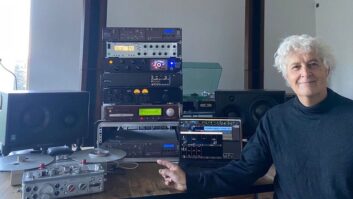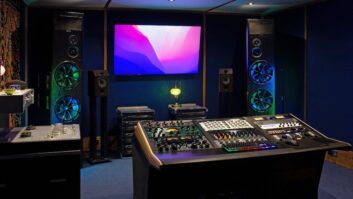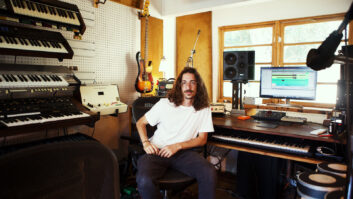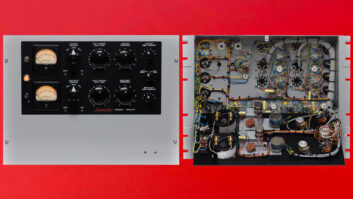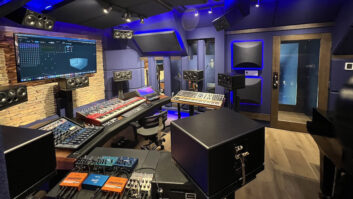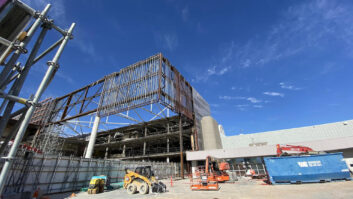

Those of us who grew up playing in bands and working with pop, rock or country songwriters are most familiar with the traditional process of producing a song — where the songwriting, pre-production, arranging and tracking each happen at different times and often in different places. But now we’re seeing a more homogenous process coming from the hip hop and rap scene, and branching into pop, R&B and other rhythm-based genres, where songwriting is increasingly becoming a part of the beatmaking process.
J.R. Rotem enjoys when an artist brings in an idea or concept as a catalyst to jump-start the session.
Before the widespread use of today’s digital production and distribution systems, hip hop or rap producers used to shop beats on cassette, CD or DAT in a highly informal manner, scribbling a phone number on the cases and passing them out to A&R, management and friends in high places. Artists would then, presumably, audition the tapes, pick a beat and write a song to it. Under this scenario, producers often worked without artist input, creating dozens of beats in the hope that somebody would like what they heard and give them a call.
CONVERGENT PROCESSES
Today, rather than being traded or sold like commodities, grooves are custom-built and ideas are mostly developed by the artist/producer relationship in the studio. But the level of the artist’s involvement and at what stage depend on a number of factors.
Typically, in pop or R&B, the producer works with songwriters tailoring music and lyrics around the artist’s persona. For hip hop, it’s slightly different: Most rappers pride themselves on writing their own music and only the hook may result from collaborating with the producer.
According to Justin “Just Blaze” Smith — the down-to-earth super-producer from New York City who gained notoriety producing such heavyweights as Snoop Dogg, Usher, Busta Rhymes and many of Jay-Z’s Roc-a-Fella records — rap has risen from being strictly a pre-fab process to one of more ebb and flow. “That’s ideal, the way I prefer it,” Blaze says. “I’ll want to get my beats to a certain level and the artist will want to do the same, so we find common ground and start bouncing ideas off each other.”
Physically, though, Blaze likes to complete the first round of beatmaking on his own before bringing his ideas to the artist — even if it’s just a matter of them hanging out in the lounge or watching some TV. “Anybody who’s artistic will understand me when I say it’s a little hard to create something with a person right over your shoulder,” Blaze adds. “Sometimes you just need to get to a certain point before you want anybody’s input.”
Similarly, Orlando-based production duo The Runners — Andrew “Dru Brett” Harr and Jermaine “Mayne” Jackson — achieve their trademark measured-and-screwed sound by producing a beat with the hook already written into the music to grab the artist’s attention. Then an artist or a team of songwriters will come into the studio to write choruses or verses. Even though the whole song may be written between producers and songwriters during pre-production, The Runners are always conscious to leave plenty of space for artists to explore their own creativity once they show up.

Just Blaze prefers an “ebb and flow process” in rap production, bouncing ideas off artists in the studio.
“Like with Beyoncé, she prefers to put in her own ad-libs and backgrounds. So, for her, we wouldn’t have the songwriter put anything in there.” Mayne says.
“And it’s amazing how much the songwriting is such a big part of the production now,” adds Dru. “It’s almost like a 50/50 thing, where we’ll have a hot beat to start with, but the right songwriting with pre-production can take it to that hit level.”
The Runners usually present a song that already has a chorus, but when working with certain rappers who are established songwriters themselves, like T.I., Akon or T-Pain, Dru and Mayne know enough to leave the hooks up to them. That’s how “We Do This” came to life for T.I. on his highly anticipated fifth album, and this summer’s blockbuster release, T.I. vs. T.I.P.
“We were at Hit Factory down in Miami working on a couple beats specifically for him,” recalls Mayne. “T.I. was scheduled to be in at 6 o’clock and it’s noon. A couple hours passed and we still had no beats, so we just chilled. About an hour before T.I. was supposed to arrive, we started with the drums and a basic Clav riff. I actually went into the booth myself and started laying down layers of harmonies, EQ’ing them to make myself sound like an old choir, you know? Then when T.I. came in, we played him the beat we just made, and it only took him about 15 minutes of vibing to it over the mains and he went right into the booth and laid down the chorus. No paper, no pen, no nothin’. Everything’s in his head, on the spot.”
With much of his songwriting happening with pre-production, T.I. came back out after laying the hook and The Runners looped the verse portions of the beat in Pro Tools so that he could develop lyrics in his head. After 10 minutes, the first verse was recorded.

MIDI Mafia (Dirty Swift, right, and Bruce Waynne) tackle an audio project by first going through their extensive catalog of beats.
“T.I. took a break and was eating in the lounge of the F room at Hit Factory, and we continued working on pre-production,” Mayne adds. “We had it up loud in the studio and somebody opened the studio door to the lounge. When he heard it, he came right in and did the same thing — vibed for about 10 minutes, went in, laid the chorus, came back out, we looped the verse portion of the beat for him again, and he went right back in and finished the whole song within an hour. And that’s one of his biggest records on his album.”
BQgKAy03NQ==
Whether it’s talent they’ve already worked with on several hit records or an artist who’s completely new to them, rap and hip hop producers tend to approach each song in a relatively similar fashion. The Runners start by trying to get in the artist’s head about the direction and the sound.
“‘Do you have your album on you?’” Mayne figuratively asks. “‘Let’s see what you’re missing. How far along are you? Do you have a single? If so, let’s hear it because we wanna beat it out.’” Beating out singles has become a fierce game within the urban-production scene.
“What the labels are trying to do is even the super-producers out and fill the rest of the album with a bunch of producers they can get for a cheaper price,” explains Dru. This competitive edge, combined with the fact that production budgets are shrinking thanks to plummeting album sales, has led many labels to encourage — even force — artists to work from a producer’s stash of beats rather than build beats from the ground up.
Bruce Waynne and Dirty Swift, aka MIDI Mafia, start by going through their extensive catalog of beats and playing as much as possible for the artists, either to hook them in or to see what they gravitate toward. An artist may love something in particular and open that session file to build upon, or nothing will immediately tweak the ears and the boys will have to start from scratch. “Sometimes they might react to something you didn’t expect,” says Swift. “Fantasia, for instance: ‘When I See U’ [the Number One single from her second album, Fantasia] wasn’t the first thing we thought she’d wanna cut.” But while she was tracking vocals, Waynne and Swift developed a clearer picture of what Fantasia was all about and began tailoring beats around her persona, fostering an integrated songwriting/production relationship with the artist in the studio.

The Runners (Andrew “Dru Brett” Harr, right, and Jermaine “Wayne” Jackson) assemble a song skeleton with the hook already written in.
“She’d be cutting vocals in one room, and we’d have a couple songwriters working in another room, running back and forth and kinda just doing things simultaneously,” Swift explains. “Without getting crazy, you wanna maximize the time you have with them. If we can write a song and sell another record, then we try to do as much as we can.”
Even producers like Blaze — who are familiar with the near blank-check approach to some sessions — are witnessing much more of a blurred line between songwriting, sound design, pre-production and arrangement. “I was just in the studio with Mariah Carey last night,” says Blaze, “and you know, our process is basically I’ll play her a few skeletons — which are just basic ideas, drum patterns, light melody or whatever — and she’ll start singing or humming something to herself. And either myself or one of my musicians would start playing along with her on top of the skeleton and we just build it from there.”
With a versatile musical background that includes classical and jazz piano, Hollywood-based super-producer J.R. Rotem enjoys it most when artists come with an idea or concept that can act as some sort of catalyst for a session. Because he’s comfortable in many genres, Rotem says his options are almost infinite, and therefore prefers to hone in on some sort of structure. He’s also careful not to let his creative license go over the heads of what an established fan base, or radio, expects.
“I’m trying to make the most commercial records I can, the ones that are going to hit the widest audiences,” Rotem says. “It has to be accessible, and a lot of times a familiar melody, sample or a melodic sensibility is what pulls people in. I think a combination of that is what makes an amazing song.”
Perhaps there’s no better example of this from Rotem’s vault of hits than “Beautiful Girls,” this summer’s blockbuster single from 17-year-old Sean Kingston from Jamaica. Kingston is the first artist signed to Beluga Heights, which is owned and run by J.R., along with younger brother and label A&R Tommy Rotem.
“We were in the studio doing some tweaks to another song and feeling kinda uninspired,” recalls Rotem. “Sean was in the kitchen of the studio, I was in the control room, and he came running in saying, ‘Hey, what’s that song, “Stand by Me?”’ Mary J. Blige was in there with him from another session, and I guess it was playing on the radio on some oldies station. Having just turned 17, Sean obviously didn’t know the song that well and asked if anybody ever flipped it before. I said, ‘No, I don’t think so. Let’s do something!’”
Rotem immediately bought the song on iTunes, unsure of whether he’d sample directly or interpolate from it. After programming a basic beat around a sample of the familiar bass intro, he added instruments to bring out the 1950s-era sound, such as sweet string pads and Celeste, which reminded him of “Mr. Sandman.”
“To be honest with you, the process of the track was very, very quick,” Rotem says. “It was like five, 10 minutes — just feeling it and building it up. Sean started singing the chorus, and right off the bat I could tell the vocals were matching the track, but the fact that he says ‘suicidal’…I mean, the whole song sounds kinda pretty and dreamy, then there’s this real edge. So I was like, ‘Wow, we have it.’”
With the track looped up, Kingston was so inspired that he asked to be left in the room where, within half an hour, he came up with all the verses. Rotem and Kingston continued back and forth with production and writing in doo-wops, and by the end of the evening the song was finished — a completely collaborative process.
EXTREME WORK HABITS
Top hip hop and rap producers generally work at breakneck speed in the studio anyway, but with financial pressures upon them from labels due to slumping album sales, they’ve learned to streamline their production process and become more innovative with new technologies.
Comfortably seated in his B room, the private pre-production temple at his SSL-equipped Baseline Recording Studios in New York City, Blaze often prepares for sessions by scouring his collection of more than 12,000 vinyl records, sampling snippets into his Akai MPC 4000, rackmount MIDI modules or software samplers for beat programming. Either way, he tracks everything into Pro Tools, as he prefers to keep things in-the-box very early on.

Producer/songwriter Ryan West is also chief engineer/production assistant to Just Blaze.
Ryan West, a producer/songwriter, and chief engineer and production assistant to Blaze for the past four years, explains the hectic pace at which he and Blaze typically work, using “Show Me What You Got” off Jay-Z’s 2006 comeback album, Kingdom Come, as an example.
“We were out in L.A. working at Westlake Studios, which was built for Michael Jackson by Quincy Jones for the Off the Wall record, so it had this incredible vibe to it,” West says. “Prior to Jay-Z’s tracking session in New York, Just and I started formulating ideas and coming up with beats. We had two laptops with Pro Tools LE, plus the main Pro Tools HD system going in the main control room. Just brought in this local working band from L.A. called 1500 and gave each of its members our sample-based beat, basically letting them go to town on it. He’d asked them for specific things like Rhodes parts, B3 parts or a straight-up piano, or whatever. One kid was a drummer, so I was working with him recording live drum overpasses while these other two guys were sitting out in the lounge with these little MIDI or USB keyboards hooked up to a laptop running virtual instruments and adding parts to the track. Meanwhile, Just was splitting around, directing traffic and controlling
what’s going on in the studio.”
Tracks in hand, the pair returned to New York where Blaze did some additional pre-production on it with Jay-Z present. After bouncing ideas and formulating what he wanted to do lyrically, Jay-Z entered the booth and spit out his vocals in one take.
“The mix process was fairly interesting, too,” continues West. “We actually mixed most of that in-the-box in Pro Tools in Just’s B room. We ended up mixing it down to stems so he could put it on one of his laptops because he was on his way to Japan to do a gig. He actually finished mixing the stems on the plane.”
Blaze uses such plug-ins as Native Instruments Battery, Luxonix Purity or IK Multimedia SampleTank, building skeleton sequences on his laptop to save and build upon when he gets back to the studio. “For travel, I’ve been checking out Ableton Live lately, which I think is a little more straightforward in terms of just pre-production than Pro Tools,” Blaze says. “On my next round of albums, it’s going to be a very big piece of what I do.”
MIDI Mafia splits studio duties pretty much straight down the middle. Sharing equally in the track-making process, Waynne handles the songwriting while Swift handles engineering. “We’re soup-to-nuts guys,” says Waynne. “I’ll go in the studio with someone and start the record — whether it’s R&B, pop, rap, whatever — to get the flow going. Our approach is very old-school, just with new technology. We embrace technology from Pro Tools to FTP server because we’re bi-coastal; I’m in New York sometimes, but Swift’s in L.A. and back and forth.” Swift adds that they’re looking at eventually upgrading to Digidesign’s DigiDelivery system.
Tag-teaming in this manner led to one of the duo’s most notable productions this summer for Jennifer Lopez. Originating from a catchy sample that Waynne stumbled across, he began to write sketchpad ideas using Spectrasonics Trilogy for its wealth of dance sounds. But coming up with a bridge proved elusive, so he went straight into the studio with a reference singer and a co-writer, and together they wrote a melody to drive the whole song based on his groove.
“Once I finally got the bridge down both lyrically and melodically, we went back in, got with Swift and musically just took out the original sample and built everything over with different chord changes,” Waynne recalls. “Altogether, it took us a solid week to do. Then we played it for J-Lo, she loved it, and it looks like it’s gonna be her first single on her English album. It really launched the whole project, and we set the tone for the album.”
For Rotem, the tangibility of zipping around a keyboard that he’s familiar with makes his Yamaha Motif ES the first thing he’ll head for when cutting a new groove. Though slowly getting into soft synths such as Synthogy’s Ivory or IK Multimedia’s Miroslav Strings, he mainly uses them to double or replace parts initially done on one of his many keyboards. From his own room at Chalice Studios in Hollywood, Rotem concludes that he really hates to travel — feeling at his best and preferring to do tracks from this “comfort zone” — so being able to pick up and go isn’t something he worries about.
Nothing could be more different for jet-set The Runners. “We had a special case built by Nashville Custom Case, and it’s actually a rackmount that fits our [Mac] G5 and all our rackmount synth gear in one box,” says Mayne. “We’re really new-school, so everything’s digital and soft synths with us. We started with the MPC way back, but we always sequenced in Pro Tools.”
That isn’t to say that The Runners’ sound — which is largely that of live recorded instruments and trademark custom drum samples — doesn’t come from organic sources before eventually ending up in Native Instruments Battery for beat programming. “Actually, I’m giving away a big secret right here,” Mayne says. “When we track our drums, we run everything through the SPL Transient Designer. Most people use that SPL in the mixing process, but we like our drums to sound a certain way, so we’re using it up-front in the pre-production process.”
CELEBRITY STATUS
Typified by the likes of Puff Daddy, Pharrell and Kanye West, the early class of urban super-producers paved the road that we ride today, where premiere beatmakers are jumping the console to share sticker space with the artist on the front of CDs. Though producers have always been key to musical success, they’re increasingly becoming stars in their own right.
“I think the rappers that are true stars are always going to be stars,” says Swift. “Nobody’s gonna outshine 50 Cent on a track because he’s just a star straight up and down. He knows how to write a hit record. But I think there are a lot of rappers out there who are kinda like one-single guys, so they’ll just find the hottest producer and just use that name to kinda boost their image.”
Blaze sees first-hand how music works in a club and on the radio, and maintains that a monster beat will steal the show every time. “I mean, when was the last time you heard a hit a cappella record?” he says with a laugh. “Off the top of my head, I can only think of Boyz II Men and Take 6. But when you have a good balance of catchy hooks and lyrical substance, then you have a career.”
Jason Scott Alexander is a producer/mixer/remixer in Ontario, Canada.

LISTEN: MIDI Mafia Must Play
Ooohh, Drama
MIDI MAFIA DISCOGRAPHY
Jennifer Lopez: “Hold It Don’t Drop It, “Heart Break”
Fantasia: “When I See You”
Deemi: “Soundtrack of My Life,” “Ima Be Alright,” I Don’t Care,” “So This Is Love,” You Were There”
Flipsyde: “Happy Birthday Remix, “Angel”
Penelope Jones (featuring Brick & Lace): “Waiting,” “My Shoes”
Brick & Lace: “Rally Back”
Bo Rilla: “Handle That”
Sam Scarfo: “Purple Haze,” “So Gangsta”
Hayes: “Whats Up Now,” “That’s OK,” “Sucka for Love”
Mack 10: “Keep It Hood,” “So Gangsta”
Players Club: “Duffle Bag Boyz”
Nelly: “Getcha Getcha”
Young Buck: “Thou Shall Not Kill”
Miri Ben-Ari (featuring Cash Money): “Its Goin Down”
Jean Grae: “You Don’t Want It”
Shaleik Rivers (featuring Juvenile): “Get to Know You”
Talib Kweli: “Rock On,” “We Got the Beat,” “Planet Rock,” “Black Girl Love”
G-Unit: “Groupie Love”
CNN: “Yes Sir”
NORE (featuring Bruce Waynne): “Pin the Tail”
Bravehearts: “Sensation,” “B Train,” “Buss My Guns”
Gemma Fox: “Messy,” “Goodman,” “Crazy,” “Love Me,” “Hurting Me”
Westside Connection: “Gotta Have Heart,” “Izm”
Tamia (featuring Talib Kweli): “Officially Missing You remix”
Lil’Mo: “Forever Remix (featuring Baby Cham),” “21 Answers (featuring Free)”
Rusty Waters (featuring 8 Ball & Juvenile): “More Cornbread Remix”
50 Cent (featuring Nate Dogg): “21 Questions”
Angie Martinez: “Never”

